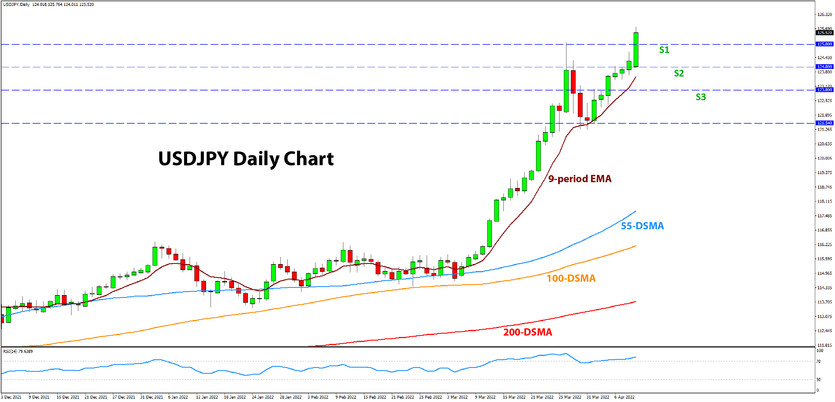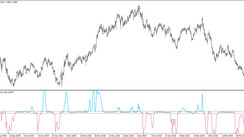USD Weekly Fundamental Outlook: 50bp Hikes and Expeditious QT Are Coming, USD to Stay Bid
The dollar is pressing on the new highs for the cycle after breaking out of the 1-month range last week. Renewed hawkish rhetoric from the Fed, this time for faster quantitative tightening (QT), pushed the greenback higher. Fed Governor Lael Brainard firstly spoke in favor of a speedier and larger QT process than previously thought, but the same vibe was also evident in the Fed meeting minutes released Wednesday, where FOMC members discussed an “expeditious” tightening of monetary policy at their latest meeting in March.
All of this is consistent with further US dollar strength going forward, albeit the trend of moderate but relatively steady gains may continue. The fact that other central banks also need to tighten policy because of rising inflation acts as a counterforce that moderates the USD’s gains. However, the hawkish Fed, coupled with a strong US economy in contrast to others and a general risk-averse mood in markets (amid the war in Ukraine and else), should continue to support the US dollar in the foreseeable future.
The highlights on the US economic calendar this week are the CPI inflation report (Tue) and retail sales (Thur). Headline inflation is forecasted to push further higher toward 8.5%, while the core CPI measure is seen around 6.5% y/y. But potentially, this could be the peak month as negative base effects will start to kick in from the next release in May. Still, 8.5% y/y CPI will be more than enough to keep the Fed firmly hawkish for the time before inflation starts to come down later this year.
EUR Weekly Fundamental Outlook: Under Pressure as EU Doubles Down on Plans to Ban Russian Energy
The euro gapped higher on the weekly open following last night’s French election results, which showed sitting President Emmanuel Macron (27.6% of votes) leading relatively comfortably ahead of far-right candidate Marine Le Pen (23.4% of votes). The modest EUR recovery comes after the sizable decline last week driven by new EU sanctions on Russia and fears for even stronger actions on banning energy imports from Russia.
While some extension of the EUR relief rally is possible in the very near term on the French election results, it’s worth remembering that (unlike in 2017) the risk of a Le Pen victory was not priced too much in markets anyway. So, there is little risk premium to be priced out on a Macron win. In what will be a rematch of the 2017 election, markets now expect Macron to beat Le Pen 54% to 46% in the 2nd round on April 24 (based on polls).
The war in Ukraine and Western sanctions on Russia will continue to dominate the news headlines this week too. After the recent reports of committed war crimes, the EU and US have stepped up sanctions on Russia, with the EU banning coal imports - the first time to target the energy sector. There is also stronger talk of a complete ban on oil and gas. This was precisely the worst-feared scenario for the EUR currency, and it seems to be slowly unfolding now.
The focus on the Eurozone data calendar this week is the ECB meeting on Thursday. No big decisions are expected this time, and instead, the ECB is likely to repeat its communication from the March meeting. There is a modest risk for a hawkish surprise, however. The latest surge in prices, which pushed Eurozone CPI above 7% y/y could inspire some hawks within the ECB to voice support for earlier rate hikes.
While a slight hawkish surprise from the ECB could push the euro higher in the near term, the broad context remains unchanged for the EUR currency. Ultimately, the negative economic outlook due to the war in Ukraine will likely curb any ECB hawkishness, thus keeping the EUR weak in the coming months.
EURUSD Technical Analysis:
EURUSD broke the consolidation channel last week and tested the 1.08 zone but didn’t reach the level itself. Still, there is potential for the bearish move to extend this week if we get a continuation to the downside.
The key technical zone to watch remains 1.10. It is a key resistance in the current context because it is where the broken support line of the channel now stands, in addition to it being a psychologically and historically important level. The bearish bias will remain intact as long as EURUSD is below 1.10.
The 1.08 zone will continue to be support, with the probabilities currently favoring another test or even a break below it. Under 1.08, traders will focus on round numbers like 1.07 and 1.06 as support zones. But there is no significant support until the 1.05 – 1.03 area, which is where the major lows from 2016/2017 are located.
For some context on the bigger picture (weekly chart), you can also check out this piece that we published a few weeks ago.
GBP Weekly Fundamental Outlook: The Pound (like the euro) Faces Risks from Growth Slowdown
In an uneventful past week, the pound continued to be driven by global factors and the longer-term domestic dynamics. It has remained within its established ranges in recent weeks, but the outlook is turning more negative amid the war in Ukraine and the fallout of economic relations with Russia.
Like the euro, the pound is greatly affected by the energy crisis, hurting the domestic economy. Although GBP is understandingly faring slightly better as the UK is somewhat less dependent on Russia, the correlation between the pound and the euro is high (around 70%), and we can expect this to continue. This means that both currencies will be pushed around by the war, where negative developments should be bearish, while positive news from Ukraine can set the stage for a relief rally. Technical factors also seem to be helping the pound, with GBPUSD near that 1.30 psychological area (see more below). A break below could lead to a steeper and broader GBP decline.
The UK calendar is busier this week, with the focus on employment data (Tue) and CPI inflation (Wed). As in the US, inflation is expected to push higher while the jobs market should remain in a good state. Potentially any negative surprises in the employment data could be a catalyst that fuels a sharper GBP sell-off, while the market will likely look through any CPI figures as a lot of the high numbers are already well-expected and priced in.
GBPUSD Technical Analysis:
Cable made an attempt on the 1.30 zone late Friday and today (Monday), but both were rejected, albeit marginally so as the bounce is only around 50 pips. GBPUSD is also still trading under the falling trendline that so far keeps this latest bearish leg intact (see chart below).
Thus, the overall tone here remains bearish, even if GBPUSD remains above 1.30. A break below this 1.30 zone could possibly lead to a faster, steeper decline, which could see GBPUSD reach the next important support zone at 1.2850 – 1.28.
On the other hand, the bullish (rebound) scenario would be signaled by an upside break of that falling trendline. This could open the potential for a move higher, perhaps as a new retracement leg. In this case, 1.3150 would be the first resistance zone, ahead of 1.33, which would be the more important one to watch.

JPY Weekly Fundamental Outlook: Bearish Trend Can Run Further
The yen resumed its slide as global bond yields pulled higher again while the BOJ is firmly sticking to its QE and YCC easing policies. This divergence in central bank policies was the dominant factor pushing the yen weaker in March, and it seems there is more fuel for this trend to run.
USDJPY has already risen above 125.00 today and is steadily pushing higher. The negative “perfect storm” of high commodity prices, uber-dovish BOJ, and a still relatively stable risk environment (stocks holding up well) continue to press the JPY.
With Japanese officials (both BOJ and Ministry of Finance) expressing no worries over the yen’s steep decline, it seems we could soon be trading around 130.00 in USDJPY. This, of course, implies that other JPY pairs would move higher accordingly.
Finally, the risks to the bearish JPY view are worth a reminder. Mainly those are related to risk sentiment and Treasury yields, which so far are also supportive of JPY weakness. However, if either or both of those reverse, then it will be much easier for the JPY also to reverse some of the losses.
USDJPY Technical Analysis:
USDJPY resumed the advance and is already trading above the previous high of 125.00. The pair is now only some 20-30 pips below the 2015 high of 125.85. Above it, USDJPY will reach levels not seen for 20 years. The last time USDJPY was trading at or above 130.00 was in 2001/2002.
With the bull trend in full force here, there isn’t much else to look for. The shallow retracement following the late March high and the extension above it today suggest that there are few sellers left in this market. With such dynamics in the driver seat, USDJPY looks set to reach the 130.00 area in the coming days and weeks.
To the upside, round number levels such as 126.00, 127.00, etc., can be viewed as modest resistance junctures on the chart and as points to potentially take some profits. But the big resistance is all the way up at 130.00.






